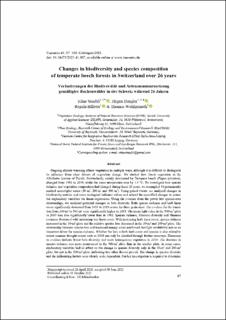Please use this identifier to cite or link to this item:
https://doi.org/10.21256/zhaw-23427Full metadata record
| DC Field | Value | Language |
|---|---|---|
| dc.contributor.author | Staubli, Eline | - |
| dc.contributor.author | Dengler, Jürgen | - |
| dc.contributor.author | Billeter, Regula | - |
| dc.contributor.author | Wohlgemuth, Thomas | - |
| dc.date.accessioned | 2021-11-10T07:56:50Z | - |
| dc.date.available | 2021-11-10T07:56:50Z | - |
| dc.date.issued | 2021-10-31 | - |
| dc.identifier.issn | 0722-494X | de_CH |
| dc.identifier.issn | 0373-7632 | de_CH |
| dc.identifier.uri | https://digitalcollection.zhaw.ch/handle/11475/23427 | - |
| dc.description.abstract | Ongoing climate warming affects vegetation in multiple ways, although it is difficult to distinguish its influence from other drivers of vegetation change. We studied how forest vegetation in the Albiskette (canton of Zurich, Switzerland), mainly dominated by European beech (Fagus sylvatica), changed from 1993 to 2019, while the mean temperature rose by 1.5 °C. To investigate how species richness and vegetation composition had changed during these 26 years, we resampled 46 permanently marked nested-plot series (30 m², 200 m² and 500 m²). Using paired t-tests, we analysed changes in biodiversity metrics and mean ecological indicator values and related the quantified changes to poten-tial explanatory variables via linear regressions. Using the z-values from the power law species-area relationships, we analysed potential changes in beta diversity. Both species richness and herb layer cover significantly decreased from 1993 to 2019 across the three grain sizes. The z-values for the transi-tion from 200 m² to 500 m² were significantly higher in 2019. The mean light value in the 500-m2 plots in 2019 was also significantly lower than in 1993. Species richness, Shannon diversity and Shannon evenness decreased with increasing tree layer cover. With increasing herb layer cover, species richness increased in the 30-m2 plots and the relative species loss decreased in the 30-m2 and 200-m2 plots. The relationship between species loss and increased canopy cover confirmed that light availability acts as an important driver for species richness. Whether the loss in both herb cover and species is also related to recent summer drought events such as 2018 can only be clarified through further resurveys. Decreases in z-values indicate lower beta diversity and more homogenous vegetation in 2019. The decrease in species richness was more pronounced in the 500-m2 plots than in the smaller plots. In some cases, explanatory variables had an effect on the change in species diversity only in the 30-m² and 200-m² plots, but not in the 500-m² plots, indicating that other drivers prevail. The change in species diversity and the influencing factors were clearly scale dependent. Further investigation is required to determine whether our findings are merely region-specific or also valid in other biogeographical regions. To ensure that further species loss does not go unnoticed, we recommend the continuation of coordinated resurvey studies and monitoring. | de_CH |
| dc.language.iso | en | de_CH |
| dc.publisher | Floristisch-Soziologische Arbeitsgemeinschaft | de_CH |
| dc.relation.ispartof | Tuexenia | de_CH |
| dc.rights | Licence according to publishing contract | de_CH |
| dc.subject | Beech forest | de_CH |
| dc.subject | Switzerland | de_CH |
| dc.subject | Biodiversity | de_CH |
| dc.subject | Canopy closure | de_CH |
| dc.subject | Climate change | de_CH |
| dc.subject | Drought | de_CH |
| dc.subject | Ecological indicator value | de_CH |
| dc.subject | Resurvey | de_CH |
| dc.subject | Permanent plot | de_CH |
| dc.subject | Vegetation change | de_CH |
| dc.subject.ddc | 333.7: Landflächen, Naturerholungsgebiete | de_CH |
| dc.subject.ddc | 580: Pflanzen (Botanik) | de_CH |
| dc.title | Changes in biodiversity and species composition of temperate beech forests in Switzerland over 26 years | de_CH |
| dc.type | Beitrag in wissenschaftlicher Zeitschrift | de_CH |
| dcterms.type | Text | de_CH |
| zhaw.departement | Life Sciences und Facility Management | de_CH |
| zhaw.organisationalunit | Institut für Umwelt und Natürliche Ressourcen (IUNR) | de_CH |
| dc.identifier.doi | 10.21256/zhaw-23427 | - |
| zhaw.funding.eu | No | de_CH |
| zhaw.originated.zhaw | Yes | de_CH |
| zhaw.pages.end | 108 | de_CH |
| zhaw.pages.start | 87 | de_CH |
| zhaw.publication.status | publishedVersion | de_CH |
| zhaw.volume | 41 | de_CH |
| zhaw.publication.review | Peer review (Publikation) | de_CH |
| zhaw.webfeed | Vegetationsökologie | de_CH |
| zhaw.author.additional | No | de_CH |
| zhaw.display.portrait | Yes | de_CH |
| Appears in collections: | Publikationen Life Sciences und Facility Management | |
Files in This Item:
| File | Description | Size | Format | |
|---|---|---|---|---|
| 2021_Staubli_et_al_Changes_in_biodiversity_and_species_composition_Tuexenia.pdf | 26.35 MB | Adobe PDF |  View/Open |
Show simple item record
Staubli, E., Dengler, J., Billeter, R., & Wohlgemuth, T. (2021). Changes in biodiversity and species composition of temperate beech forests in Switzerland over 26 years. Tuexenia, 41, 87–108. https://doi.org/10.21256/zhaw-23427
Staubli, E. et al. (2021) ‘Changes in biodiversity and species composition of temperate beech forests in Switzerland over 26 years’, Tuexenia, 41, pp. 87–108. Available at: https://doi.org/10.21256/zhaw-23427.
E. Staubli, J. Dengler, R. Billeter, and T. Wohlgemuth, “Changes in biodiversity and species composition of temperate beech forests in Switzerland over 26 years,” Tuexenia, vol. 41, pp. 87–108, Oct. 2021, doi: 10.21256/zhaw-23427.
STAUBLI, Eline, Jürgen DENGLER, Regula BILLETER und Thomas WOHLGEMUTH, 2021. Changes in biodiversity and species composition of temperate beech forests in Switzerland over 26 years. Tuexenia. 31 Oktober 2021. Bd. 41, S. 87–108. DOI 10.21256/zhaw-23427
Staubli, Eline, Jürgen Dengler, Regula Billeter, and Thomas Wohlgemuth. 2021. “Changes in Biodiversity and Species Composition of Temperate Beech Forests in Switzerland over 26 Years.” Tuexenia 41 (October): 87–108. https://doi.org/10.21256/zhaw-23427.
Staubli, Eline, et al. “Changes in Biodiversity and Species Composition of Temperate Beech Forests in Switzerland over 26 Years.” Tuexenia, vol. 41, Oct. 2021, pp. 87–108, https://doi.org/10.21256/zhaw-23427.
Items in DSpace are protected by copyright, with all rights reserved, unless otherwise indicated.